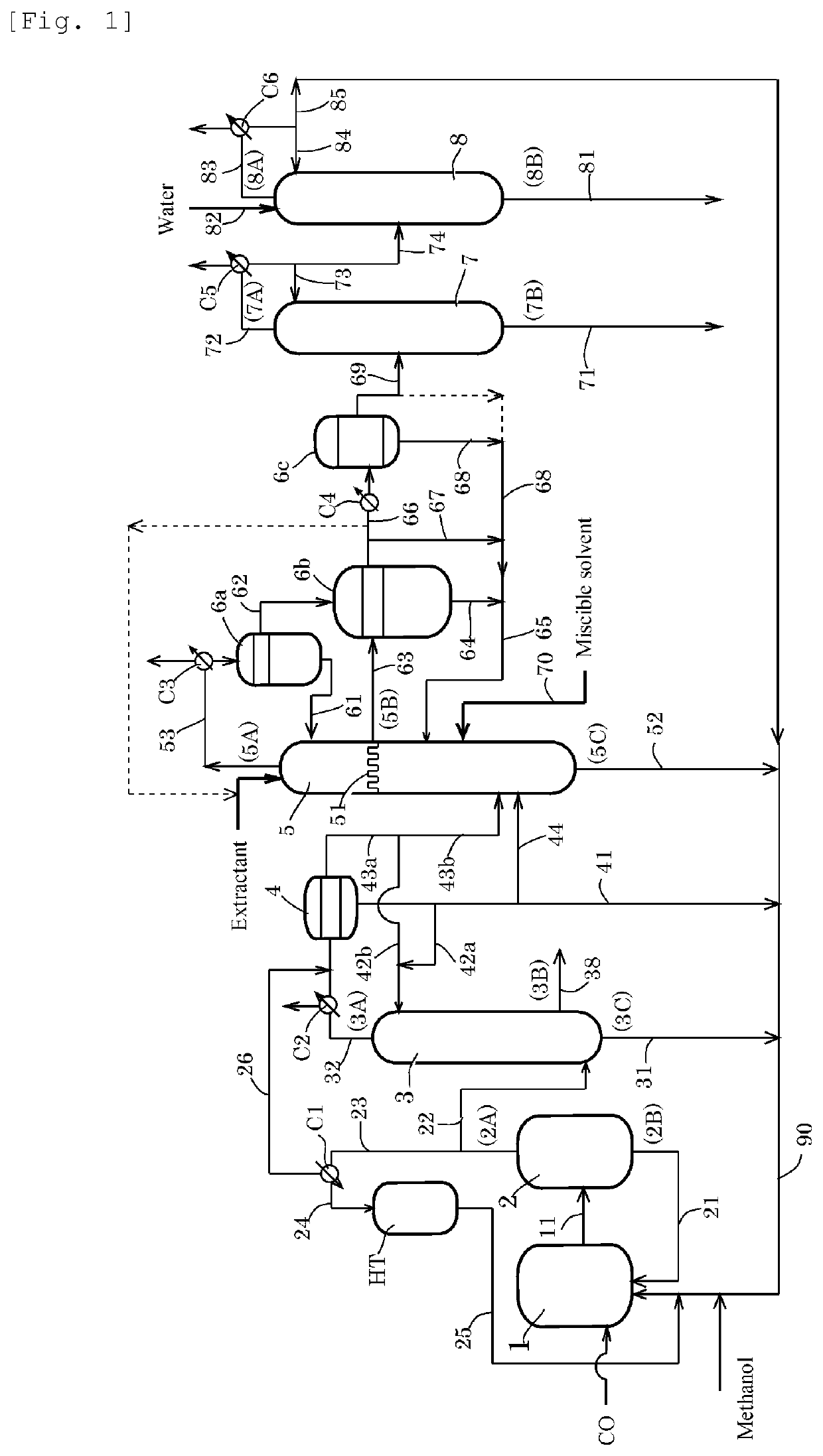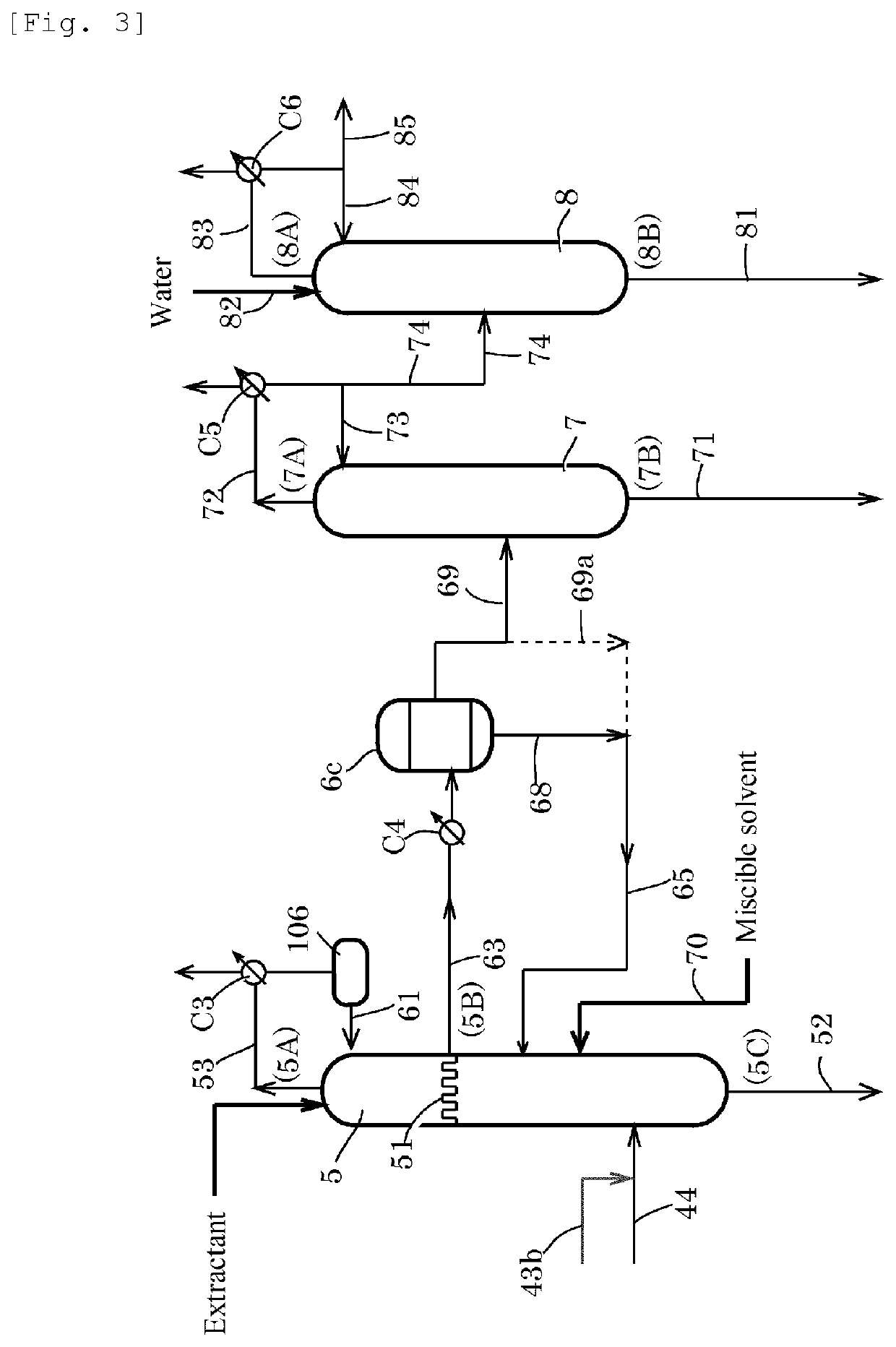Process for producing acetic acid
a technology of acetic acid and process, which is applied in the direction of carbon monoxide reaction carboxylic preparation, halogenated hydrocarbon preparation, etc., can solve the problems of low quality of product acetic acid, difficulty in efficiently separating acetaldehyde and methyl iodide from each other by ordinary distillation means alone, and inability to extract methyl iodide into the aqueous phase. , to achieve the effect of efficient separation,
- Summary
- Abstract
- Description
- Claims
- Application Information
AI Technical Summary
Benefits of technology
Problems solved by technology
Method used
Image
Examples
example 1
[0212]A second distillation column 5 having the actual number of stages of 43 [column top temperature of 23° C., column bottom temperature of 47° C., column top pressure of atmospheric pressure+10 mmH2O (about 100 Pa)] was provided. A feed liquid (a line 44, temperature: 20° C.) was fed to the 7th plate from the bottom of the distillation column at a rate of 1295 g / h, and water (temperature: 20° C.) was fed to the 43rd plate from the bottom of the distillation column at a rate of 12.5 g / h. An overhead (temperature: 23° C.) from a line 53 was cooled in condenser C3 to 7° C. and was refluxed at a reflux rate of 576 g / h for water extractive distillation in the column. The feed liquid was a methyl iodide solution having an AD concentration of 1960 ppm, a MA concentration of 14.8% by weight, a water concentration of 0.7% by weight, and an AC concentration of 1.8% by weight. A chimney tray was installed instead of the third plate below the top of the column, and the whole amount of the fa...
example 2
[0215]A second distillation column 5 having the actual number of stages of 43 [column top temperature of 22° C., column bottom temperature of 47° C., column top pressure of atmospheric pressure+10 mmH2O (about 100 Pa)] was provided. A feed liquid (a line 44, temperature: 20° C.) was fed to the 7th plate from the bottom of the distillation column at a rate of 1302 g / h, and water (temperature: 20° C.) was fed to the 43rd plate from the bottom of the distillation column at a rate of 12.5 g / h. An overhead (temperature: 22° C.) from a line 53 was cooled in condenser C3 to 7° C. and was refluxed at a reflux rate of 937 g / h for water extractive distillation in the column. The feed liquid was a methyl iodide solution having an AD concentration of 1940 ppm, a MA concentration of 14.8% by weight, a water concentration of 0.7% by weight, and an AC concentration of 2.1% by weight. A chimney tray was installed instead of the third plate below the top of the column, and the whole amount of the fa...
example 3
[0219]A second distillation column 5 having the actual number of stages of 43 [column top temperature of 22° C., column bottom temperature of 47° C., column top pressure of atmospheric pressure+10 mmH2O (about 100 Pa)] was provided. A feed liquid (a line 44, temperature: 20° C.) was fed to the 7th plate from the bottom of the distillation column at a rate of 1279 g / h, and water (temperature: 20° C.) was fed to the 43rd plate from the bottom of the distillation column at a rate of 12.6 g / h. An overhead (temperature: 22° C.) from a line 53 was cooled in condenser C3 to 7° C. and was refluxed at a reflux rate of 688 g / h for water extractive distillation in the column. The feed liquid was a methyl iodide solution having an AD concentration of 1960 ppm, a MA concentration of 14.8% by weight, a water concentration of 0.7% by weight, and an AC concentration of 1.8% by weight. A chimney tray was installed instead of the third plate below the top of the column, and the whole amount of the fa...
PUM
| Property | Measurement | Unit |
|---|---|---|
| retention time | aaaaa | aaaaa |
| height | aaaaa | aaaaa |
| pressure | aaaaa | aaaaa |
Abstract
Description
Claims
Application Information
 Login to View More
Login to View More - R&D
- Intellectual Property
- Life Sciences
- Materials
- Tech Scout
- Unparalleled Data Quality
- Higher Quality Content
- 60% Fewer Hallucinations
Browse by: Latest US Patents, China's latest patents, Technical Efficacy Thesaurus, Application Domain, Technology Topic, Popular Technical Reports.
© 2025 PatSnap. All rights reserved.Legal|Privacy policy|Modern Slavery Act Transparency Statement|Sitemap|About US| Contact US: help@patsnap.com



